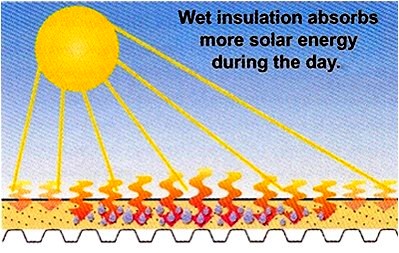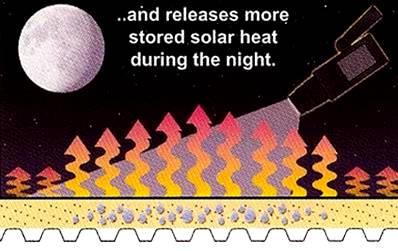
How does infrared thermography work?
Infrared thermography is the use of an infrared imaging and measurement camera to “see” and “measure” thermal energy emitted from an object. Infrared imagers “see” the heat radiated from your roof surface and surrounding equipment in real time.
During the day, the sun radiates energy onto the roof and into the roof substrate, and then at night, the roof radiates the heat back into outer space. This is called radiational cooling. Areas of the roof that are of a higher mass (wet) retain this heat longer than that of the lower mass (dry) areas. Infrared imagers can detect this heat and “see” the warmer, higher mass areas, during the “window” of uneven heat dissipation. Heat loss and other IR services can be performed at the same time.
Most IR scans are done at night in order to capture this thermal signature of wet insulation trapped in a roofing system. It is common to precisely mark these damaged areas of wet insulation with spray paint on the roof surface. A CAD drawing is then produced identifying wet areas throughout the roof sections.
IR scans work best when conditions provide for a distinct temperature difference between the interior and exterior of the building. Additionally, optimal conditions are at night following a sunny day and when nighttime temperatures cool quickly. The greater the rate of outside temperature change, the greater the difference in surface temperatures between the wet and dry areas.
There are some limitations to IR scans. Ponding water or any precipitation within the last 24 hours prior to the scan may lead to inaccurate readings.
IR scans will only detect moisture in the top roof system. If there are multiple roofs on the building and moisture is trapped in the lower roof, an IR scan will not detect this moisture.
It is important to remember that IR scans work on the principle of solar gain and temperature difference. When multiple roofs are on a building, the trapped moisture in the lower roof never acquires the heat it needs to be detected by an IR scan. Additional constructions that can produce false readings with IR scans include ballasted systems, lightweight concrete decks, and roofs with highly reflective roof surfaces.
Additionally, most IR scans are done in the summer when the solar gain is greatest. As cooler temperatures arrive, especially in the northern climates, it is very difficult to get accurate results because the solar gain is so limited. However, some professionals will use IR technology to identify heat loss in winter months.
Wet insulation, as well as windows, doors and other gaps allow heat from within the building to escape. This heat loss is identified with IR technology.
By using the information generated by a X-Vision report, the building owner or manager can make smart decision related to the recommend cost-effective removal and replacement of wet components.
Problem areas can now be corrected without the tremendous expense of replacing the entire roof.





